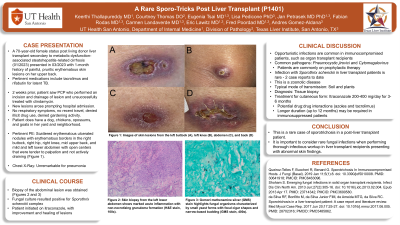Sunday Poster Session
Category: Liver
P1401 - A Rare Sporo-Tricks Post Liver Transplant
Sunday, October 27, 2024
3:30 PM - 7:00 PM ET
Location: Exhibit Hall E

Has Audio

Keerthi Thallapureddy, MD
University of Texas Health San Antonio
San Antonio, TX
Presenting Author(s)
Keerthi Thallapureddy, MD1, Courtney Thomas, DO1, Eugenia Tsai, MD2, Lisa Pedicone, PhD2, Jan Petrasek, MD, PhD2, Fabian Rodas, MD2, Carmen Landaverde, MD3, Eric J. Lawitz, MD4, Fred Poordad, MD2, Andres Gomez-Aldana, MD2
1University of Texas Health San Antonio, San Antonio, TX; 2Texas Liver Institute, San Antonio, TX; 3Texas Liver Institute, Austin, TX; 4The Texas Liver Institute, University of Texas Health, San Antonio, TX
Introduction: Sporotrichosis, caused by Sporothrix, is a fungal infection acquired through skin contact and presents as suppurative and granulomatous nodules. We present a rare case of sporotrichosis in a post-liver transplant patient.
Case Description/Methods: A 70-year-old female with history of living donor liver transplant secondary to MASH one year prior presented to the emergency room with 1 month of painful, pruritic erythematous skin lesions on her upper back. Medications included tacrolimus, mycophenolate mofetil, and rifabutin for latent tuberculosis. She had initially seen her primary care doctor who performed an incision and drainage of the lesion and treated with clindamycin. However, new lesions continued to arise on her abdomen, right gluteus, knee, and left axilla and she was admitted to the hospital. She had no respiratory symptoms. She denied any illicit intravenous drug use or any recent travel.
Physical exam was notable for scattered erythematous ulcerated nodules with erythematous borders in the right buttock, right hip, right knee, mid upper back, and mid and left lower abdomen with open centers that were tender to palpation and not actively draining (Panel A). Chest X-ray was normal. Biopsy of abdominal lesion (Panel B) was obtained and fungal culture (Panel C) was positive for Sporothrix schenckii complex. Patient was started on itraconazole, with improvement and healing of the lesions.
Discussion: Opportunistic infections are common in immunocompromised patients such as liver transplant patients. Common pathogens include Pneumocystis jirovici and Cytomegalovirus, for which patients are initiated on prophylactic medications. However, infection with Sporothrix schenckii in liver transplant patients is rare and is only described in two case reports to date. It is commonly transmitted to humans by soil and plants; however, our patient denied any gardening activity.
Tissue biopsy is required for diagnosis confirmation. Sporothrix infection can be treated with itraconazole 200 mg daily for 2-4 weeks. There is risk for medication interaction between azoles and tacrolimus, so it is important to reduce the dosage of tacrolimus and monitor closely. This case highlights the importance of considering rare fungal infections when performing a thorough workup in liver transplant recipients presenting with abnormal skin findings.

Disclosures:
Keerthi Thallapureddy, MD1, Courtney Thomas, DO1, Eugenia Tsai, MD2, Lisa Pedicone, PhD2, Jan Petrasek, MD, PhD2, Fabian Rodas, MD2, Carmen Landaverde, MD3, Eric J. Lawitz, MD4, Fred Poordad, MD2, Andres Gomez-Aldana, MD2. P1401 - A Rare Sporo-Tricks Post Liver Transplant, ACG 2024 Annual Scientific Meeting Abstracts. Philadelphia, PA: American College of Gastroenterology.
1University of Texas Health San Antonio, San Antonio, TX; 2Texas Liver Institute, San Antonio, TX; 3Texas Liver Institute, Austin, TX; 4The Texas Liver Institute, University of Texas Health, San Antonio, TX
Introduction: Sporotrichosis, caused by Sporothrix, is a fungal infection acquired through skin contact and presents as suppurative and granulomatous nodules. We present a rare case of sporotrichosis in a post-liver transplant patient.
Case Description/Methods: A 70-year-old female with history of living donor liver transplant secondary to MASH one year prior presented to the emergency room with 1 month of painful, pruritic erythematous skin lesions on her upper back. Medications included tacrolimus, mycophenolate mofetil, and rifabutin for latent tuberculosis. She had initially seen her primary care doctor who performed an incision and drainage of the lesion and treated with clindamycin. However, new lesions continued to arise on her abdomen, right gluteus, knee, and left axilla and she was admitted to the hospital. She had no respiratory symptoms. She denied any illicit intravenous drug use or any recent travel.
Physical exam was notable for scattered erythematous ulcerated nodules with erythematous borders in the right buttock, right hip, right knee, mid upper back, and mid and left lower abdomen with open centers that were tender to palpation and not actively draining (Panel A). Chest X-ray was normal. Biopsy of abdominal lesion (Panel B) was obtained and fungal culture (Panel C) was positive for Sporothrix schenckii complex. Patient was started on itraconazole, with improvement and healing of the lesions.
Discussion: Opportunistic infections are common in immunocompromised patients such as liver transplant patients. Common pathogens include Pneumocystis jirovici and Cytomegalovirus, for which patients are initiated on prophylactic medications. However, infection with Sporothrix schenckii in liver transplant patients is rare and is only described in two case reports to date. It is commonly transmitted to humans by soil and plants; however, our patient denied any gardening activity.
Tissue biopsy is required for diagnosis confirmation. Sporothrix infection can be treated with itraconazole 200 mg daily for 2-4 weeks. There is risk for medication interaction between azoles and tacrolimus, so it is important to reduce the dosage of tacrolimus and monitor closely. This case highlights the importance of considering rare fungal infections when performing a thorough workup in liver transplant recipients presenting with abnormal skin findings.

Figure: Panel A. Image of the lesion from left buttock.
Panel B. Skin biopsy from the left lower abdomen shows marked acute inflammation with non-necrotizing granuloma formation (H&E stain, 100x).
Panel C. Gomori methenamine silver (GMS) stain highlights fungal organisms characterized by small yeast forms with focal cigar shapes and narrow-based budding (GMS stain, 400x).
Panel B. Skin biopsy from the left lower abdomen shows marked acute inflammation with non-necrotizing granuloma formation (H&E stain, 100x).
Panel C. Gomori methenamine silver (GMS) stain highlights fungal organisms characterized by small yeast forms with focal cigar shapes and narrow-based budding (GMS stain, 400x).
Disclosures:
Keerthi Thallapureddy indicated no relevant financial relationships.
Courtney Thomas indicated no relevant financial relationships.
Eugenia Tsai indicated no relevant financial relationships.
Lisa Pedicone indicated no relevant financial relationships.
Jan Petrasek indicated no relevant financial relationships.
Fabian Rodas indicated no relevant financial relationships.
Carmen Landaverde indicated no relevant financial relationships.
Eric Lawitz: 89Bio – Consultant, Grant/Research Support. Akero – Consultant, Grant/Research Support. Alnylam – Consultant, Grant/Research Support. Amgen – Consultant, Grant/Research Support. AstraZeneca – Consultant, Grant/Research Support. Axcella Health – Consultant, Grant/Research Support. Boehringer Ingelheim – Consultant, Grant/Research Support. Bristol Myers Squibb – Consultant, Grant/Research Support. CymaBay, a Gilead Sciences Company – Consultant, Grant/Research Support. CytoDyn – Consultant, Grant/Research Support. DSM – Consultant, Grant/Research Support. Durect – Consultant, Grant/Research Support. Eli Lilly – Consultant, Grant/Research Support. Enanta – Consultant, Grant/Research Support. Enyo – Consultant, Grant/Research Support. Exalenz – Consultant, Grant/Research Support. Galectin – Consultant, Grant/Research Support. Galmed – Consultant, Grant/Research Support. Genentech – Consultant, Grant/Research Support. Genfit – Consultant, Grant/Research Support. Gilead Sciences, Inc. – Consultant, Grant/Research Support. GSK – Consultant, Grant/Research Support. Hanmi – Consultant, Grant/Research Support. Hightide – Consultant, Grant/Research Support. Intercept – Consultant, Grant/Research Support. Inventiva – Consultant, Grant/Research Support. Ipsen – Consultant, Grant/Research Support. Janssen – Consultant, Grant/Research Support. Madrigal – Consultant, Grant/Research Support. Merck & Co – Consultant, Grant/Research Support. NGM – Consultant, Grant/Research Support. Northsea – Consultant, Grant/Research Support. Novartis – Consultant, Grant/Research Support. Novo Nordisk – Consultant, Grant/Research Support. Pfizer – Consultant, Grant/Research Support. Poxel Co – Consultant, Grant/Research Support. Roche – Consultant, Grant/Research Support. Sagimet – Consultant, Grant/Research Support. Terns – Consultant, Grant/Research Support. Viking – Consultant, Grant/Research Support. Zydus – Consultant, Grant/Research Support.
Fred Poordad indicated no relevant financial relationships.
Andres Gomez-Aldana indicated no relevant financial relationships.
Keerthi Thallapureddy, MD1, Courtney Thomas, DO1, Eugenia Tsai, MD2, Lisa Pedicone, PhD2, Jan Petrasek, MD, PhD2, Fabian Rodas, MD2, Carmen Landaverde, MD3, Eric J. Lawitz, MD4, Fred Poordad, MD2, Andres Gomez-Aldana, MD2. P1401 - A Rare Sporo-Tricks Post Liver Transplant, ACG 2024 Annual Scientific Meeting Abstracts. Philadelphia, PA: American College of Gastroenterology.
